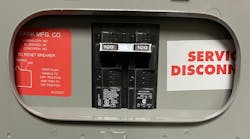Q. I understand the Code allows me to use Type AC cable with an equipment grounding (bonding) conductor for branch circuits serving patient care areas. Can I use Type MC cable with an equipment grounding (bonding) conductor for luminaires located above 7.5 feet in a patient care area?
A. No. Branch circuits that serve patient care areas must be installed in a metal raceway or listed cable with a metallic armor or sheath that qualifies as an effective ground-fault current path in accordance with 250.118 [517.13(A)]. This includes the branch circuits that supply luminaires in patient care areas.
The metal armored sheath of Type AC cable is listed as a suitable ground-fault current path for this application because it contains an internal bonding strip in direct contact with the metal sheath of the cable [250.118(8)]. Typically, the outer metal sheath of interlocked Type MC cable isn’t listed as a suitable ground-fault current path [250.118(10)]. Therefore, Type MC cable of the interlock type — where the outer sheath is not listed as an effective ground-fault current path — is not permitted to supply any branch circuit in patient care areas of health care facilities [517.13].



